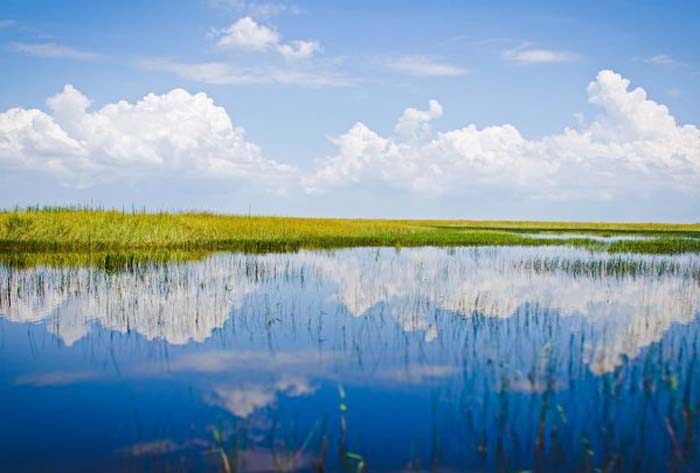
The Everglades are a vast network of subtropical freshwater wetland and estuarine ecosystems that once spanned the length and breadth of South Florida. Fifty years of dredging and diking, starting in 1948, greatly reduced their extent, altering water flow patterns and causing widespread ecological damage. Above, sawgrass prairie in Everglades National Park. Photo credit G. Gardner, National Park Service – a commons image.
Tears for the Magnificent and Shrinking Everglades, a ‘River of Grass’
Florida’s freshwater wonder is threatened like never before with a rising sea level as restoration efforts lag.
By
For years, whenever I found myself in Miami with an afternoon to spare, I sneaked off west to where a road abruptly separates the urban grid from the Everglades. Depending on time, I drove as deep into the saw grass void as I could, parked, got out and gazed up at tropical clouds racing unimpeded by tree or building.
Then, usually, I burst into tears
Sky and grass. Nothing else. It’s a bit embarrassing to admit that anything in Florida — with its postcard palms plastered against postcard sunsets, its coconut tanning oil and Lily Pulitzer pinks and greens, its schmaltz and buffoonery and hanging chads and “Florida Man,” with his love of Styrofoam, weapons and monster trucks — affects me this way. But it does.
“There are no other Everglades in the world. They are, they have always been, one of the unique regions of the earth; remote, never wholly known,” Marjory Stoneman Douglas wrote in her 1947 book, “The Everglades: River of Grass.” “The spears prick upward, tender green, glass green, bright green, darker green, to spread the blossoms and the fine seeds like brown lace,” she wrote. “The grass stays. The fresh river flows.”
Florida Bay has not recovered from a great sea grass die-off in 2015 because of unusual salinity caused by the man-made diversion of fresh water away from the bay. All Florida shores have also been plagued by a series of deadly red tides caused by fertilizer and other pollutants. Worse, as sea levels rise around Florida, increased salinity on the edges of the Everglades is killing the saw grass, setting off a cycle of damage to the sediment, allowing even more salty water farther inland.”
Where it’s not diverted or blocked by human engineering, the water still trickles south at the rate of a quarter mile a day, as it has for millenniums. But it is profoundly imperiled by pollution, human schemes to drain and control it, animal and plant invasives and sea level rise. As salt water breaches the limestone bedrock around the Florida peninsula and enters the aquifer, this natural freshwater wonder is threatened like never before.

Marjory Stoneman Douglas wrote in her 1947 book, “The Everglades: River of Grass.”
I’ve traveled far but never found a place where the Garden of Eden and the Fall of Man are so palpable in one place
I am not alone. I know by the way eyes fill with tears when people get to talking about the glades. The Everglades were designated a national park in 1947, the same year that its most ardent fan, the environmentalist Douglas, published her book.
By then, dredging and pumping and draining of the sloughs — the technical term for the shallow, slow-moving water under the grasses — and species decimation was well underway.
If doubt remains that Eden and the Fall coexist here, consider that the name of the author who extolled the wonders of this paradise is affixed to a school — the Marjory Stoneman Douglas High School in Parkland — forever associated with the 2018 school massacre that left 17 people dead.

